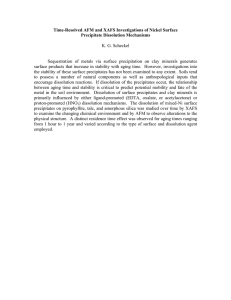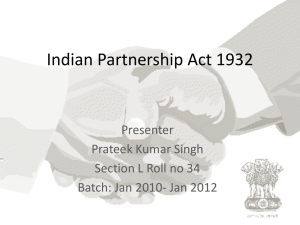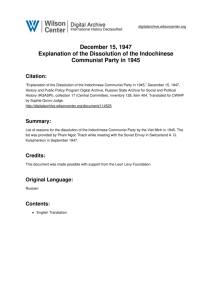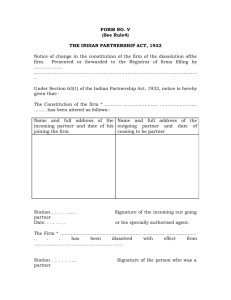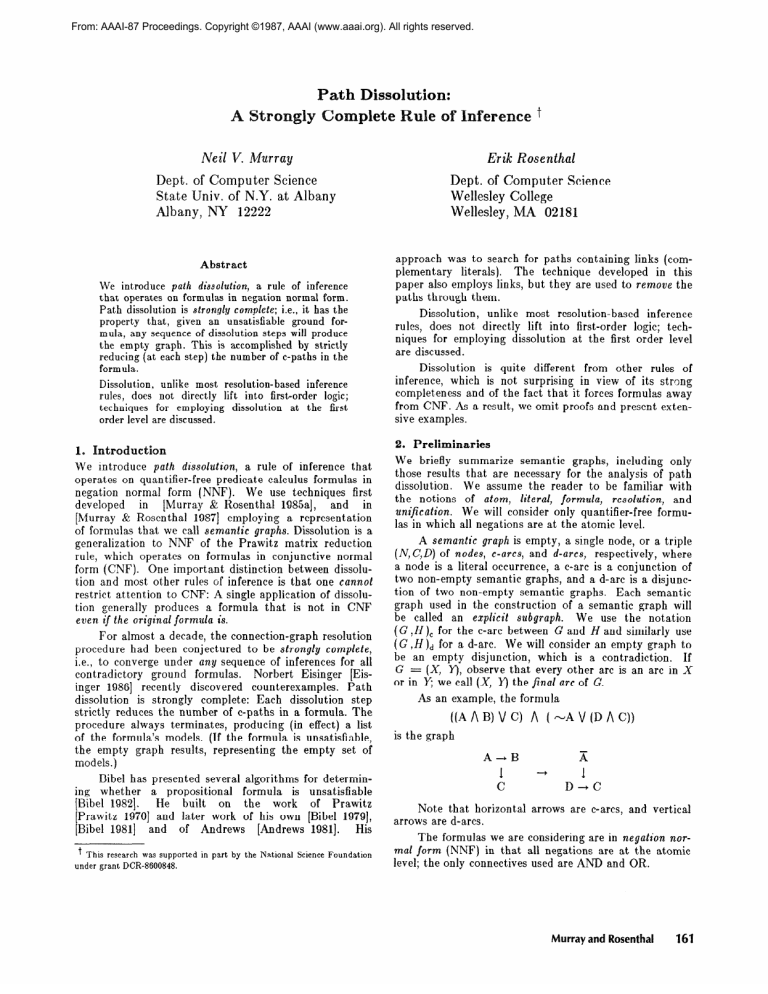
From: AAAI-87 Proceedings. Copyright ©1987, AAAI (www.aaai.org). All rights reserved.
Path
A Strongly
Dissolution:
Complete
Neil V. Murray
Erik Rosenthal
Dept. of Computer Science
State Univ. of N.Y. at Albany
Albany, NY 12222
Dept. of Computer Science
Wellesley College
Wellesley, MA 02181
approach was to search for paths containing
links (complementary
literals).
The technique
developed
in this
paper also employs links, but they are used to remove the
paths through them.
Dissolution,
unlike most resolution-based
inference
rules, does not directly
lift into first-order
logic; techniques for employing
dissolution
at the first order level
are discussed.
Dissolution
is quite different
from other rules of
inference,
which is not surprising
in view of its strGng
completeness
and of the fact that it forces formulas away
from CNF. As a result, we omit proofs and present extensive examples.
2. Preliminaries
1. Introduction
We introduce
path dissolution, a rule of inference
that
operates on quantifier-free
predicate
calculus formulas in
negation
normal form (NNF).
We use techniques
first
developed
in
[Murray & Rosenthal
1985a],
and
in
[Murray & Rosenthal
19871 employing
a representation
of formu1a.s that we call semantic graphs. Dissolution is a
generalization
to NNF of the Prawitz
matrix reduction
rule, which operates on formulas in conjunctive
normal
form (CNF).
One important
distinction
between dissolution and most other rules of inference is that one cannot
restrict attention
to CNF: A single application
of dissolution generally
produces
a formula that is not in CNF
even ij the original formula is.
For almost a decade, the connection-graph
resolution
procedure
had been conjectured
to be strongly complete,
i.e., to converge under any sequence of inferences for all
contradictory
ground formulas.
Norbert
Eisinger
[Eisinger 19861 recently
discovered
counterexamples.
Path
dissolution
is strongly
complete:
Each dissolution
step
strictly reduces the number of c-paths in a formula. The
procedure
always terminates,
producing
(in effect) a list
of the formula’s models. (If the formula is unsatisfiable,
the empty graph results, representing
the empty set of
models.)
Bibel has presented
several
ing whether
a propositional
[Bibel 19821.
He built
on
[Prawitz 19701 and later work
of Andrews
[Bibel 19811 and
t This
under
research
grant
was
supported
DCR-8600848.
in part
by
algorithms
for determinformula
is unsatisfiable
the
work
of Prawitz
of his own [Bibel 19791,
[Andrews 19811. His
the
National
Science
Foundation
We briefly
those results
dissolution.
the notions
unification.
las in which
summarize
semantic
graphs, including
only
that are necessary for the analysis of path
We assume the reader to be familiar with
of atom, literal, formula, resolution, and
We will consider only quantifier-free
formuall negations are at the atomic level.
A semantic graph is empty, a single node, or a triple
(N, C,O) of nodes, c-arcs, and d-arcs, respectively,
where
a node is a literal occurrence,
a c-arc is a conjunction
of
two non-empty
semantic graphs, and a d-arc is a disjunction of two non-empty
semantic graphs.
Each semantic
graph used in the construction
of a semantic graph will
be called an explicit subgraph. We use the notation
(G ,H), for the c-arc between G and H and similarly use
(G ,H )d for a d-arc. We will consider an empty graph to
be an empty disjunction,
which is a contradiction.
If
G = (X, Y), observe that every other arc is an arc in X
or in Y, we call (X, Y) the final arc of G.
As an example,
the formula
((A r\ B) V C) A ( --A
V (D A C))
is the graph
;;I
A+B
1
C
Note that horizontal
arrows are d-arcs.
--)
1
D+C
arrows
are c-arcs,
and vertical
The formulas we are considering are in negation normal form (NNF) in that all negations
are at the atomic
level; the only connectives
used are AND and OR.
Murray and Rosenthal
Lemma 1. Let G be a semantic
graph, and let A
and B be nodes in G. Then there is a unique arc connectding A and B.
One of the keys to our analysis is the notion of path.
Let G be a semantic graph. A partial c-path through G is
a set c of nodes such that any two are connected by a carc. A c-path id a partial c-path that is not properly contained in any partial c-path.
We similarly define d-path
using d-arcs instead of c-arcs. Several other authors have
for
example
see
[Andrews 19811,
employed
paths;
[Bibel 19791, [Bibel 19811, [Bibel 19821, [Eisinger 19861,
concen[Murray 19821, [P rawitz 19701. They generally
trated on c-paths.
Lemma 2. Let G be a semantic
graph.
Then an
interpretation
I satisfies (falsifies) C 8 I satisfies (falsifies)
every literal on some c-path (d-path) through G.
We will frequently
find it useful to consider subgraphs that are not explicit; that is, given any set of
nodes, we would like to define that part of the graph that
corisists of exactly the giiren set of nodes. The previous
example is shown below on the left. The subgraph
relative to the set {A, A, D} is the graph on the right.
7i:
A+B
1
C
-
1
D-+C
ic
A-+
1
D
If N is the node set of a graph G, and if N ’ C N,
we define GN I , the subgruph of G relative to N ’ , as
follows: If N ’ = N, then GN I = G. If the final arc
of G is (X, Y), and if no node in N ’ appears in Y (or in
X), then GN t = X, I (or G, I = Y, I ). Otherwise, GN I =(xNr,
Y,r
), where this arc is of the
same type as (X, Y). In practice,
we typically will not
distinguish between N ’ and G, I .
A c-block C is a subgraph of a semantic graph with
the property that any c-path p that includes at least one
node from C passes through
C; that is, the subset of p
consisting of the nodes that are in C is a c-path through
C. A d-block is similarly defined with d-paths, and a full
block is a subgraph that is both a c-block and a d-block.
We define a strong c-block in a semantic graph G to be a
subgraph
C of G with the property
that every c-path
through G contains a c-path through C. A strong d-block
is similarly defined.
The fundamental subgraphs of a semantic
graph G
are defined recursively as follows. If G = (X, Y )c, and if
the final arc of X is a d-arc, then X is a fundamental
subgraph of G. Otherwise,
the fundamental
subgraphs
of X
are fundamental
subgraphs
of G. (The dual case when
G = (X, Y ), is obvious.)
An
isomorphism
from
W CA
to
(N’,C’,D’)
is a bijection
f: N + N ’
that
preserves
c- and d-paths
such that for each A in N,
A=f(A).
We call Theorems
1 and 1’ and their corollaries the Isomorphism Theorem.
Theorem 1. Let G be a semantic graph, and let B
be a full block in G. Then B is a, union of fundamental
subgraphs of some explicit subgraph of G.
162
Automated Reasoning
Theorem 1’ . If G and H are isomorphic
graphs, then H can be formed by reassociating
muting some,of the arcs in G.
semantic
and com-
Corollary 1. Let G be a semantic graph, and let B
be a full block in G. Then there is a semantic
graph
G I and an isomorphism
f: G - G ’ such that f(B) is
an explicit subgraph of G ’ .
Corollary
a full block.
2.
The intersection
of two full blocks
is
Corollary 3. Given a semantic graph G and a collection of mutually disjoint full blocks, there is a graph
isomorphic
to G in which each full block is an explicit
subgraph.
Moreover,
given any two of the blocks, each
node in one is c-connected
to each node in the other or
each node in one is d-connected
to each node in the
other.
Several additional
definitions are necessary to define
the dissolution operation.
From the isomorphism
theorem
we know that any full block U is a conjunction
or a disjunction
of fundament,al
subgraphs
of some explicit subgraph H. If the final arc of H is a conjunction,
then we
define the c-extension of U to be Hand the d-extension of
U to be U itself. (The situation is reversed if the final arc
of H is a d-arc.) We define the c-path extension of an
arbitrary
subgraph
H in a semantic
graph G as follows
(note that this is different from the c-extension
of a full
block): Let F,, . . . , F, be the fundamental
subgraphs of
G that meet H, and let Fkfl, . . . , F, be those that do
not. Then
CPE(0,G)
CPE(H
= 0
and
CPE(G,G)
=
G.
,G) = CPE(HF,,Fl)
V * - * V CPE(HFn,Fn)
if the final arc of G is a d-arc
CPE(H,G)
= CPE(HQ’,)
A - - - A CPE(HF,,Fk)
A
Fk+l A * . * A Fn
if the final arc of G is a c-arc
Lemma 3. The c-paths of CPE(H,
the c-paths of G that pass through H.
G) are precisely
Using the same notation
we define the
graph of H in G, denoted SS( H,G), as follows:
SS(0,G)
SS(H,G)
=
G
and
strong split
SS(G,G)=0.
= SS(H,F,)
V . . . V SS(H,F,)
if the final arc of G is a d-arc
SS(H,G)’ = SS(H,F,)
v
. . * v SS(H,Fk)
A
&+I A * * - A F,
if the final arc of G is a c-arc
Lemma 4. If H is a c-block in G, then SS(H, G) is
isomorphic
to the subgraph
of G relative to the nodes
that lie on c-paths that miss H.
Define the uuxilfury subgraph Aux(H, G) of a subgraph H in a semantic graph G to be the subgraph of G
relative to the set of all nodes in G that lie on extensions
of d-paths through H to d-paths through G.
Lemma 5. If His a non-empty
subgraph
Aux(H, G) is empty iff H is a strong c-block.
of G, then
Moreover:
Aux(H,
c-block,
G) cannot contain a d-path
then so is Aux(H, G).
G; if H is a
through
Lemma
6. If H is a c-block
SS(Aux(H, G), G).
then
CPE(H,
G) =
3. Path Dissolution
We define a chain in a graph to be a set of pairs of cconnected
nodes such that each pair can simultaneously
be made complementary
by an appropriate
substitution.
A link is an element of a chain, and a chain is full if it is
not properly contained
in any other chain. A graph G is
spanned by the chain K if every c-path through G contains a link from K; in that case, we call K a resolution
chain for G.
Intuitively,
path dissolution
operates on a resolution
chain by constructing
a semantic graph whose c-paths are
exactly those that do not pass through the chain. Not all
resolution chains are candidates
for dissolution:
A special
type of chain that we call a dissolution chain (what else?)
is required.
Since single links always form dissolution
chains, the class is not too specialized.
The construction
of the dissolvent from such a chain is straightforward.
A resolution
chain H is a dissolution chain if it is a
single c-block or if it has the following form: If M is the
smallest
full block containing
H, then M = (X, Y),
where HnX and HnY
are each c-blocks.
Given a dissolution
chain H, define DV(H, n4), the
dissolvent of H in M, as follows (using the above notation):
If H is a single c-block,
then DV(H, M =
SS(H, Al). Otherwise
(i.e., if H consists of two c-blocks),
then
’
DV(H,M)
=
\
+
SS(H,
SS(H, X)
1
+
CPE(H,
SS(H, X)
1
-+ SS(H,
CPE(H,X)
We call the resulting graph the dissoequivalent
graph.
lution of G with respect to H and denote it Diss(G,H);
links are inherited in the obvious way.
The graph formed by dissolution
has strictly fewer
c-paths
were
c-paths
than the old one: All remaining
present in the old graph, and the two graphs are semantiThe original graph has only finitely
cally equivalent.
many c-paths,
and each dissolution
operation
preserves
As a result,
finitely
many dissolutions
its meaning.
(bounded a b ove by the number of c-paths in the original
graph) will yield a graph without links. If this graph is
empty, then the original1 graph was spanned; if not, then
every (necessarily linkless) c-path characterizes
a model of
the original graph.
If we dissolve on a link {A, x} in a graph in CNF,
then H = -{A, A}, X and Y are the two clauses containing A and A, respectively,
M = X U Y, Hx = (A\, =
CPE(Hx , X), and HY = {x} = CPE(H,,
Y ). Since
CPE(H,,
X) = CPE( Hy , Y) the Prawitz matrix reduction rule [Prawitz 19701 may then be used. The resulting
graph is
CPE(H,
X) + SS( H, y)
SS(H, X) ----)CPE(H,
r)
Note that Theorem 2 does not apply in this case (i.e., the
unsatisfiability
but
not
Prawitz
rule
preserves
equivalence).
4. A Dissolution Refutation
The graph below is unsatisfiable
and has 12 c-paths.
We
box the smallest full block containing
a dissolution
chain
about to be activated.
Y)
Y)
Y)
Intuitively,
DV(H, M) is a semantic
graph whose cpaths miss at least one of the c-blocks of the dissolution
chain. The only pa.ths left out are those that go through
the dissolution
chain and hence are unsatisfiable.
Notice
that we may express DV(H, AQ in either of the two more
compact forms shown below (since CPE(H, X) U SS(H, X)
= X and CPE(H, Y) U SS( H, Y) = Y):
x
SS(H,X)
-
1
-
SS(H,Y)
CPE(H,Y)
SS(H,X)
CPE(N,X)
---, Y
-
1
SS(H,Y)
Note that the three representations
are semantically
equivalent but are not in general isomorphic; in particular
their d-paths need not be the same. The c-paths of all
three representations,
however, are identical; they consist
of exactly those c-paths in M that do not pass through H.
Links 1 and 2 form a dissolution chain; M = (X, Y ),
where X and Y are the two leftmost fundament-al
sudr
graphs of the entire graph.
Notice that SS({C,D}, X) =
XiA,B) and SS({c,D},
Y) = YIKEj; also CPE({C,D},
X)
X qc D). Dissolution
removes 4 c-paths resulting in
ze fo\ lo&ng graph ( we use the second of the two compact versions of dissolvent throughout
this section):
Theorem
2. Let H be a ground dissolution chain in
a graph G, and let M be the smallest full block containing H. Then it4 and DV(H , M) are equivalent.
We may therefore
select an arbitrary
dissolution
chain H in G and replace the smallest full block containing H by its dissolvent, producing (in the ground case) an
Murray and Rosenthal
163
5. &plying
dissolution to a satis%iable graph.
We may always apply dissolution
to a ground semantic
graph until the graph is without links. The remaining cpaths,
if any, characterize
exactly
the interpretations
satisfying
the graph. We must not, however, apply the
Pure Lemma if that is our objective since it, unlike dissolution, preserves only satisflability,
not equivalence.
The graph below is similar
example but is satisfiable.
to that
of the previous
6
The subgraph c -+ b and the single occurrence of C
are both linkless full blocks. (We have not deleted links
or
sense
of
[Bibel 19811
ordinary
in
the
IMurray & Rosenthal
1985b].
With
path
dissolution,
links simply disappear
because their associated
nodes,
although
c-connected
in the original graph, become dWe may therefore apply the
connected
in the dissolvent.)
Pure Lemma [Bibel 19811, [Murray & Rosenthal
1985b],
19871 and delete the d-extensions
[Murray & Rosenthal
of these full blocks, which in turn renders the upper
occurrence of A pure. The result is:
l
AT
1--+x-+
E
D
Now we activate
link 3 and apply the Pure Lemma
to A:
D
--)
1
E
We next dissolve
on link 4 to produce:
;D
D
.
E
I
I
The details, which are similar to the previous example,
are left to the reader because of space considerations.
After six dissolutions
(activating-a
total of-10 lisks), the
graph is reduced to A --* C + D + E -+ D --) B, which
specifies those interpretations
that satisfy the original
graph.
6. First Order Dissolution
B
3
1
--+
“\z
$
The remaining two links constitute
a single strong c-block
and they span the entire graph.
Dissolving
on them
results in the empty graph.
The
usual
arguments
(involving
the application
of
Robinson’s
Unification
Theorem)
allow us to lift ground
chains to the general level. More stringent
conditions,
however, must be satisfied if we wish to replace the smallest full block containing
a dissolution chain by its dissolvent. (Were this not the case, we would have a decision
procedure
for first order satisflability.)
The difficulty
arises from ground instances (possibly crucial to a proof)
in which the chain does not exist, i.e., instances that are
not consistent with the mgsu of the chain. Of course, the
dissolvent
can always be soundly conjoined to the existing graph.
Dissolution
(with replacement)
may then be
applied freely to the newly inferred portion of the graph.
A partial replacement
technique may be applied to chains
that link the old and new sections of the graph. These
ideas are discussed in this section.
During the construction
of the mgsu of a chain, some
care must be taken regarding the familiar process of standardizing
variables
apart.
If x is any variable,
two
apart if they
occurrences
of x cannot be standardized
appear in d-connected
nodes. In CNF this is a sufficient
condition
for determining
whether
variables
may be
standardized
apart; in semantic graphs (NNF), this is not
the case. What is required is the transitive
closure of the
relation
‘are d-connected’,
which
provides
all the
occurrences of x that are in fact the same variable.
6.11. Partia1
replacement
Let G be a (first order) semantic graph, and let H be
a dissolution
chain with mgsu Q in the full block M
=(X,
Y),. Let U= DV(H, M) and consider the graph
G --) Ua
164
Automated Reasoning
If we have a dissolution
chain in Ua, we may dissolve
with replacement
since anything
lost due to successive
instantiations
is present in G. If we have a dissolution
chain from G to U, the smallest full block containing
it
will consist of a fundamental
subgraph of G and a fundamental subgraph of U. (This full block could be larger if
the chain contains a strong c-block.) We of course cannot
replace the fundamental
in G, but we may replace the
funda.mental
in U by the entire dissolvent.
The following
example illustrates
these ideas. It consists of five fundamental c-connected
subgraphs,
labeled F, through F5 .
A(x) 1
E(x)
1
E(x)3
1
.-+
I+
B(x) 4 C(x)
W)
1
B7;
1
--,
-,
E(+D(x)
--r D(x)
Do)
1
-qqq+D(hTGIJ
Ft3
F6
Suppose that we first dissolve on link 1; the smallest
full block containing
it (F, conjoined with F, ), and its
dissolvent, are shown below.
Am1
Et4
1
W(x))
Qdv))
’
---)
1
A(&))
1
E@(x))
F5
Fl
--P
Wkb)))
Am
1
+
A(&))
1
wv))
E(7vj) --) A(&)
Wdv)))
1
B(W)
FD
-
C(W)
4
AkW
Fll
from
the
link
, the fundamental
1
--)
E(W))
There are now two d-connected
occurrences
of the
also
c-block B( h( v)) -+ C(h(v)); the two taken together
form a c-block.
Each is linked to (g(,), m)d,
a strong
c-block in F4. Dissolving results in replacing F7 with:
FL2
Wtdv)))
E@(v)) C&v))) f, D&ih)
F9
FI,
W(v)) 4 W&H)
Fls
F14
The proof may be completed
F6
3
10
The c-block consisting
of B(f(g(vk+D(_f(g(v)))
in
F,,
is linked to the strong c-block (B(x), D(xj)d within
F, of the original graph. Replacing F r2 by the dissolvent
yields (we omit F8 ):
w(v))
In the original graph, several occurrences
of x can be
standardized
apart (although
we have not done so), but
in the dissolvent,
all occurrences
of v are d-related.
The
has
created
two
d-connected
dissolution
operation
occurrences
of the literal E(h(v)),
both of which are
in the original graph.
Therefore these two
linked to E(x)
links are descendants
of the original link, and they form a
dissolution
chain that is somewhat
easier to find (given
the appropriate
bookkeeping)
than an arbitrary
two-link
chain.
Shown below is F, , the result of dissolving on
this chain.
E(hlo)
B(W)) --) C(W))
F
F9
4dv))
W(x))
F4
J’s
EkW)
1 W&N)
A(dx))
1
F8
F2
-
N&
a dissolvent
is computed
we replace only F,,
Kw
w%dv)))h
that meets G(f(g(v))).
W(x))
Fx
Em
E(x)----1
B(x)- C(x)
ZBrn\
+
F16
using F,,
1
G(x)-+D(X)
-+ A(dv))
*
F,,
Fll
and Fr4:
EkW)
J-2
Dissolving on link 2 produces
linked to F4 by a dissolution
graph.
6.2.
B(g(v)) ---f C(g(v)), which is
chain that spans the entire
Dissolution on copies of graphs
In the previous technique,
dissolution
was used once
within the original graph to create an inferred graph on
which replacement
could safely be performed.
Another
strategy would be to create a copy of the original graph,
and then dissolve with replacement on the copy as much
as possible.
The idea is to drive the copy toward some
instantiated
linkless consequence,
which is then conjoined
to the original graph.
(If we are lucky, the consequence
will be empty!) The process can then be repeated,
with
preference
given to those links (if any) not used in previous iterations.
Note that in general,
as dissolution
is
applied, some links not yet used in the copy will simply
vanish, their literals having become instantiated
in ways
inconsistent
with their original unifiers.
Let us try this approach on the previous example.
Links 1 through 6 are compatible.
Regardless of the order
in which they are activated,
the resulting graph contains
Murray and Rosenthal
165
all c-paths
except
those through
Computer
316336.
any of the six links.
[Kowalski
Fl
F2
F3
We omit the individual
only the result:
dissolution
steps,
and
These techniques
look promising, but both are primitive; much remains to be investigated
at the first order
level. Our intuition
is strong that dissolution
at the
ground level is likely to be an effective technique,
and we
cannot help but believe that, if properly lifted, it would
also be effective for first order logic.
Acknowledgements
We would
Shurr, without
multiple
systems
like to thank
Stacia
whose help we could
in multiple
geographic
Quimby
not have
[Andrews
& Rosenthal
1985a]
N.V. Murray and E.
lution and Semantic
EUROCAL
‘85, Linz
In Lecture
Note8
Springer-Verlag,
vol.
proving via general
28,2, pp. 193-214,
[Bibel 19811
W. Bibel, “On matrices with connections,”
J.ACM, vol. 28,4, pp. 633-645, Oct. 1981.
[Bibel 19821
W. Bibel, “A comparative
proof procedures,”
Artificial
18,3, pp. 269-293, 1982.
[Brown
19761
F. Brown, “Notes on chains and connection
graphs,” Personal notes, Department
of Computation
and Logic, Edinburgh
University,
1976.
[Chang
& Slagle
19791
C.L. Chang and J.R. Slagle, “Using rewriting
rules
for
connection
graphs
to
prove
theorems,”
Artificial
Intelligence, vol. 12, pp.
154178, Aug. 1979.
19861
N. Eisinger,
“What you always wanted
to
about
clause
know
resolution,”
graph
Proceedings
of the
Eighth
International
Conference
on Automated
Deduction,
Oxford,
England,
July 1986.
In Lecture
Notee in
Automated Reasoning
study of several
Intelligence,
vol.
Rosenthal,
“Path ResoGraphs,” Proceedings
of
Austria, April 1-3, 1985.
in Computer
Science,
204, 50-63.
[Murray
& Rosenthal
1985101
N.V. Murray and E. Rosenthal,
“Path ResoProceedings
of
lution With Link Deletion,”
IJCAI-85, pp. 1187-1193, UCLA, Aug. 18-24,
1985.
[Murray
& Rosenthal
19871
N.V. Murray and E. Rosenthal,
“Inference
With Path Resolution and Semantic Graphs,”
To appear in J.ACM, vol. 34,2, April 1987.
[Prawitz
19701
“A proof procedure with matrix
D. Prawitz,
Lecture
Notes in Mathematics,
reduction,”
vol. 125, pp. 207-213, Springer-Verlag,
1970.
[Robinson
19651 J.A. Robinson,
“A machine
oriented
logic
based on the resolution
principle,”
J.ACM,
vol. 12,1, pp. 23-41, 1965 .
[Stephan
& Siekmann
1978)
W. Stephan and J. Siekmann,
“Completeness
and soundness of the connections graph proof
Conference
on
A ISB/ GI
procedure,”
Artificial
intelligence
(D. Sleeman,
ed.), pp.
340-344, Leeds University
Press, 1978, Hamburg, July 18-20, 1978.
[Stickel
19811 P.B. Andrews, “Theorem
J.ACM,
vol.
matings,”
April 1981.
W. Bibel, “Tautology
testing with a generalized matrix reduction
method,”
Theoretical
Computer Science, vol. 8, pp. 31-44, 1979.
166
[Murray
locations.
[Bibel 19791
[Eisinger
19821
and Scott
dealt with
References
Vol. 230,
“An experimental
theorem
N.V.
Murray,
prover using fast unification and vertical path
graphs,” Proc. of the Fourth National Conf.
of Canadian Society of Computational
Studies
125-131,
U.
of
of
Intelligence,
pp.
Saskatchewan,
May 1982.
[Murray
present
The semantic
graph above has 6 c-pa.ths, whereas
the original one has 48. Dissolving on links ‘7 and 8 yields
the empty graph.
Springer-Verlag,
“A proof procedure using con19751 R. Kowalski,
J.ACM, vol. 22,4, pp. 572nection graphs,”
595, Oct. 1975.
F6
J’4
Science,
1982)
M.L. Stickel, “A nonclausal connection-graph
Proc.
resolution
theorem-proving
program,”
AAAI-82 Nat. Conf. on Artificial Intelligence,
pp. 229-233, Pittsburgh,
Pennsylvania,
Aug.
1982.


